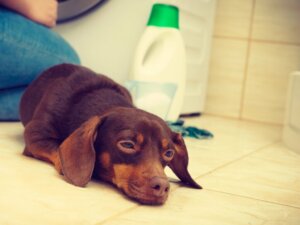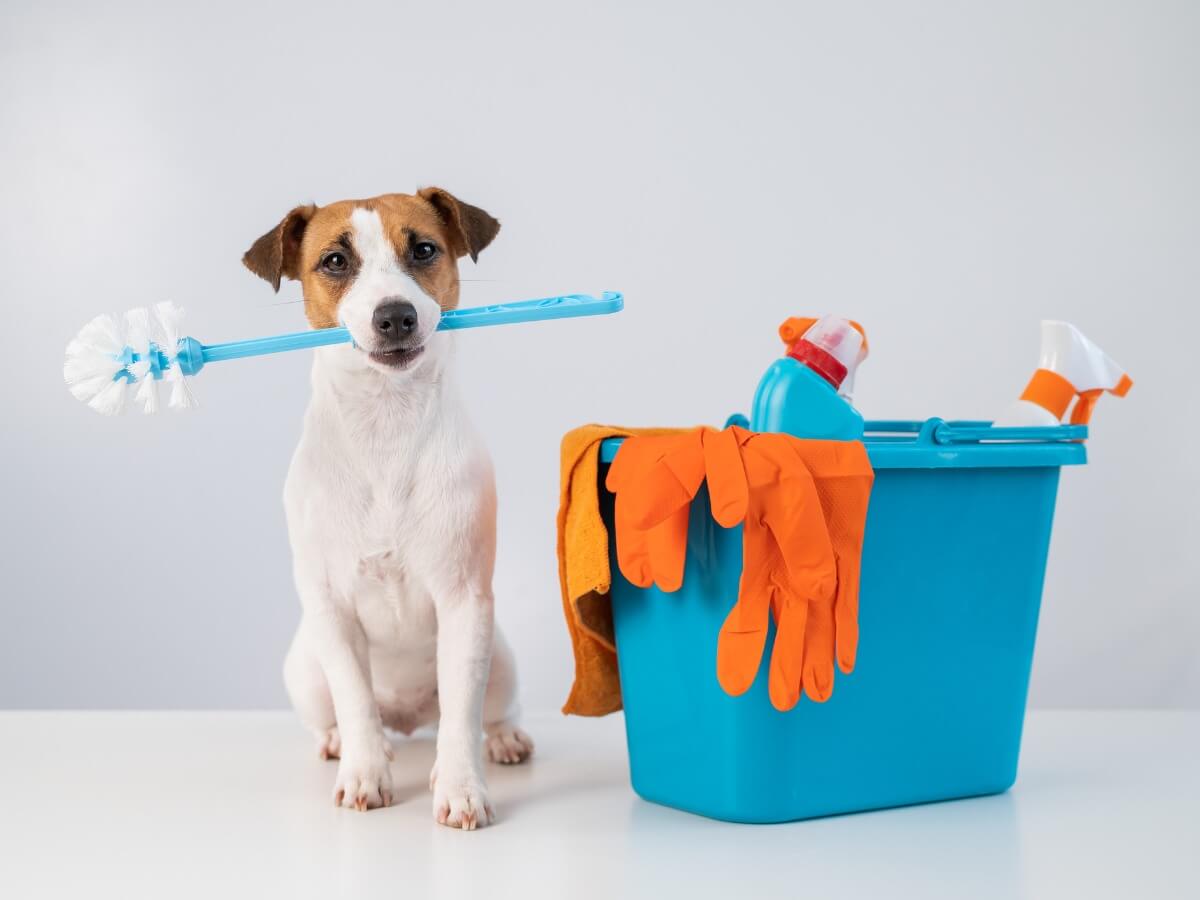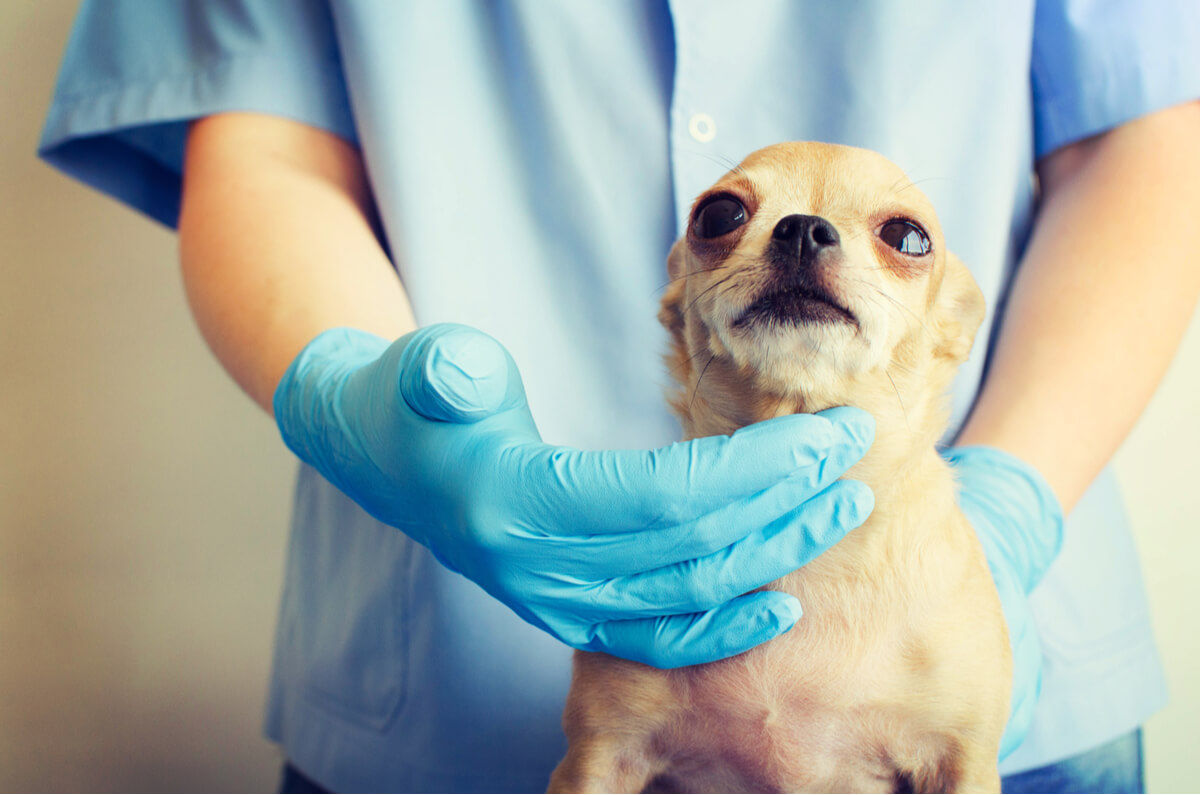My Dog Has Drunk Bleach: What Should I Do?


Written and verified by the biologist Samuel Sanchez
The term bleach encompasses a series of oxidizing substances that are used in homes around the world as disinfectants, as they’re useful to kill fungi and bacteria. Pets are constantly indirectly exposed to these chemicals, and for this reason, having your dog drink bleach is a situation you must be prepared for. So, what should you do if your dog has drunk bleach?
Depending on the concentration of the active ingredients, bleach can harm your dog’s body to varying degrees. Whatever the case, it’s better to treat all cases as emergency poisonings, in order to avoid problems and irreversible damage in the short term. Next, we’ll tell you everything you need to know about this situation and how to deal with it.
What is bleach poisoning?
As we’ve said, bleach is a compound in an aqueous solution with general bactericidal and fungicidal properties. The main compound in these products is sodium hypochlorite, a strong oxidant which is lethal to various microorganisms. Although it works well against “active” viruses, bacteria, and fungi, it’s less effective against spores and quiescent phases.
The European Economic Community (EEC) establishes the following degrees of “safety” of the different varieties of bleach, in relation to their sodium hypochlorite content:
- Non-irritating: Having less than 5% sodium hypochlorite.
- Irritants: 5-10% sodium hypochlorite.
- Caustics: More than 10% of the compound.
To date, all the products marketed contain a sodium hypochlorite concentration of between 3.15% and 6.3%. That is, they can be non-irritating or irritating cleaning products, but never caustic. In any case, these criteria are used for human beings and it can be quite different in dogs.
Pathogenic mechanism
As indicated by the MSD Veterinary Manuals portal, a bleach with a hypochlorite concentration lower than 10% will be a mild irritant for a dog. Due to its oxidizing effect, it can cause damage to the mucous membranes of the mouth, pharynx and esophagus, as well as gastritis if large quantities are ingested.
If the product has a pH greater than 11 or less than 3.5 and the hypochlorite concentration exceeds “safe” limits, damage to the canid’s gastrointestinal tract can occur. Special care must be taken with ultra-concentrated products —pH of 12-12.5—, as these can cause significant clinical symptoms in both pets and humans.

How do I know if my dog has drunk bleach?
Most household bleaches are irritating, but not caustic or corrosive. Therefore, the clinical signs are usually quite mild. If a dog ingests a small amount of commercial bleach — 3.5-6% hypochlorite — symptoms will begin within minutes. We can highlight the following:
- Excessive drooling: Although this clinical sign occurs in dogs, it’s even more evident in cats.
- Irritation of the skin of the mouth and oral mucosa: As these are the first places that come into contact with the chemical, they’re the ones that most show irritation and possible damage.
- Vomiting: Nausea and vomiting aren’t very common after exposure to household bleach. However, if the dog has drunk a lot, it may unintentionally bring up some of its food. Vomiting is more common after ingesting bleaches with other compounds (color-safe bleach).
- Atypical behaviors: The dog may bring its front legs to its nose, as if it were trying to “scratch” itself.
These clinical signs may seem worrisome, but they indicate a mild condition. However, concentrated products do cause both external and internal ulcerations. These are evidenced in the form of bleeding, visible oral lesions, diarrhea, hypotension, seizures, and loss of motor skills.
A poisoning from consuming concentrated bleach can only be solved with professional medical attention.
What do I do if my dog has drunk bleach?
We come to the most important part, because every tutor must know how to act in the face of a picture of chemical poisoning in dogs. Of course, the approach will depend on the type and amount of chemical ingested. Let’s look at the routes of action in low and low spectra separately.
Limited consumption and mildly irritating bleach
If your dog drinks a little household bleach by mistake, be vigilant but keep calm. Try to get it to drink plenty of water quickly, in order to further dilute the bleach and promote natural rinsing of the mouth environment. A cup of milk will be ideal if the dog tolerates it, as this will help to “neutralize” the action of the chemical.
Once the dog has ingested enough fluid, the symptoms should begin to subside within 30-45 minutes. If this isn’t the case, go with your pet to the vet, as it may need some extra treatment.
Consumption of concentrated bleach
If your dog has consumed concentrated bleach, you should go to the emergency room with them without wasting a second. At the veterinary clinic, the animal may be given a stomach lavage or vomiting induction, depending on the condition and the severity of the symptoms it presents.
If the animal is very weak and can’t eat, it may be given fluids and nutrients intravenously (fluid therapy), in order to avoid dehydration and other imbalances. On the other hand, we emphasize that activated carbon in these cases is useless, as it isn’t effective against the chemical compounds of bleach.
If your dog has drunk bleach and you have any questions or concerns, it’s best to go to the vet.

Final notes
Mild cases don’t usually require veterinary attention and resolve themselves quickly, in 35-40 minutes. If your dog has drunk bleach, just encourage them to drink liquid, and, if possible, give them some milk.
However, concentrated poisonings are much more serious and may require prolonged veterinary assistance. Long-term ulcerations and deep injuries in the dog may need to be treated, requiring the help of drugs and accessory therapies.
Beyond visits to the vet and professional approaches, as in all poisonings, the best treatment is prevention. Always keep the bleach in an inaccessible place for your pets, and, if you’re cleaning, close the door of the living room and keep them in another room.
The term bleach encompasses a series of oxidizing substances that are used in homes around the world as disinfectants, as they’re useful to kill fungi and bacteria. Pets are constantly indirectly exposed to these chemicals, and for this reason, having your dog drink bleach is a situation you must be prepared for. So, what should you do if your dog has drunk bleach?
Depending on the concentration of the active ingredients, bleach can harm your dog’s body to varying degrees. Whatever the case, it’s better to treat all cases as emergency poisonings, in order to avoid problems and irreversible damage in the short term. Next, we’ll tell you everything you need to know about this situation and how to deal with it.
What is bleach poisoning?
As we’ve said, bleach is a compound in an aqueous solution with general bactericidal and fungicidal properties. The main compound in these products is sodium hypochlorite, a strong oxidant which is lethal to various microorganisms. Although it works well against “active” viruses, bacteria, and fungi, it’s less effective against spores and quiescent phases.
The European Economic Community (EEC) establishes the following degrees of “safety” of the different varieties of bleach, in relation to their sodium hypochlorite content:
- Non-irritating: Having less than 5% sodium hypochlorite.
- Irritants: 5-10% sodium hypochlorite.
- Caustics: More than 10% of the compound.
To date, all the products marketed contain a sodium hypochlorite concentration of between 3.15% and 6.3%. That is, they can be non-irritating or irritating cleaning products, but never caustic. In any case, these criteria are used for human beings and it can be quite different in dogs.
Pathogenic mechanism
As indicated by the MSD Veterinary Manuals portal, a bleach with a hypochlorite concentration lower than 10% will be a mild irritant for a dog. Due to its oxidizing effect, it can cause damage to the mucous membranes of the mouth, pharynx and esophagus, as well as gastritis if large quantities are ingested.
If the product has a pH greater than 11 or less than 3.5 and the hypochlorite concentration exceeds “safe” limits, damage to the canid’s gastrointestinal tract can occur. Special care must be taken with ultra-concentrated products —pH of 12-12.5—, as these can cause significant clinical symptoms in both pets and humans.

How do I know if my dog has drunk bleach?
Most household bleaches are irritating, but not caustic or corrosive. Therefore, the clinical signs are usually quite mild. If a dog ingests a small amount of commercial bleach — 3.5-6% hypochlorite — symptoms will begin within minutes. We can highlight the following:
- Excessive drooling: Although this clinical sign occurs in dogs, it’s even more evident in cats.
- Irritation of the skin of the mouth and oral mucosa: As these are the first places that come into contact with the chemical, they’re the ones that most show irritation and possible damage.
- Vomiting: Nausea and vomiting aren’t very common after exposure to household bleach. However, if the dog has drunk a lot, it may unintentionally bring up some of its food. Vomiting is more common after ingesting bleaches with other compounds (color-safe bleach).
- Atypical behaviors: The dog may bring its front legs to its nose, as if it were trying to “scratch” itself.
These clinical signs may seem worrisome, but they indicate a mild condition. However, concentrated products do cause both external and internal ulcerations. These are evidenced in the form of bleeding, visible oral lesions, diarrhea, hypotension, seizures, and loss of motor skills.
A poisoning from consuming concentrated bleach can only be solved with professional medical attention.
What do I do if my dog has drunk bleach?
We come to the most important part, because every tutor must know how to act in the face of a picture of chemical poisoning in dogs. Of course, the approach will depend on the type and amount of chemical ingested. Let’s look at the routes of action in low and low spectra separately.
Limited consumption and mildly irritating bleach
If your dog drinks a little household bleach by mistake, be vigilant but keep calm. Try to get it to drink plenty of water quickly, in order to further dilute the bleach and promote natural rinsing of the mouth environment. A cup of milk will be ideal if the dog tolerates it, as this will help to “neutralize” the action of the chemical.
Once the dog has ingested enough fluid, the symptoms should begin to subside within 30-45 minutes. If this isn’t the case, go with your pet to the vet, as it may need some extra treatment.
Consumption of concentrated bleach
If your dog has consumed concentrated bleach, you should go to the emergency room with them without wasting a second. At the veterinary clinic, the animal may be given a stomach lavage or vomiting induction, depending on the condition and the severity of the symptoms it presents.
If the animal is very weak and can’t eat, it may be given fluids and nutrients intravenously (fluid therapy), in order to avoid dehydration and other imbalances. On the other hand, we emphasize that activated carbon in these cases is useless, as it isn’t effective against the chemical compounds of bleach.
If your dog has drunk bleach and you have any questions or concerns, it’s best to go to the vet.

Final notes
Mild cases don’t usually require veterinary attention and resolve themselves quickly, in 35-40 minutes. If your dog has drunk bleach, just encourage them to drink liquid, and, if possible, give them some milk.
However, concentrated poisonings are much more serious and may require prolonged veterinary assistance. Long-term ulcerations and deep injuries in the dog may need to be treated, requiring the help of drugs and accessory therapies.
Beyond visits to the vet and professional approaches, as in all poisonings, the best treatment is prevention. Always keep the bleach in an inaccessible place for your pets, and, if you’re cleaning, close the door of the living room and keep them in another room.
All cited sources were thoroughly reviewed by our team to ensure their quality, reliability, currency, and validity. The bibliography of this article was considered reliable and of academic or scientific accuracy.
- Chlorine bleaches, MSD Veterinary Manuals. Recogido a 24 de junio en https://www.msdvetmanual.com/toxicology/household-hazards/chlorine-bleaches
- Bleach Poisoning in Pets: What You Should Know, PETMD. Recogido a 24 de junio en https://www.petmd.com/dog/emergency/poisoning-toxicity/bleach-poisoning-pets-what-you-should-know
- Mencías, E. (2003). Intoxicación por cáusticos. In Anales del Sistema Sanitario de Navarra (Vol. 26, pp. 191-207). Gobierno de Navarra. Departamento de Salud.
This text is provided for informational purposes only and does not replace consultation with a professional. If in doubt, consult your specialist.








